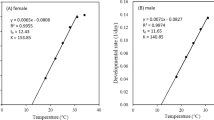Abstract
The biology ofChiracanthium mildei L. Koch was studied under standardized laboratory conditions (24±1°C, 55–60% RH). Specimens were reared from eggs, with 1- to 6-day-oldSpodoptera larvae serving as prey throughout their life cycle. Biological studies included an investigation of the rate of development, life cycle, reproductive potential and behavior, as well as the influence of certain environmental factors on these parameters. Under standard laboratory conditions,C. mildei showed 87% survival from egg to functional fertility. Males required a mean of 182 (137–207) days after hatching to reach maturity, became adults following 7–8 molts, and lived for an average of 73 days as adults. Females required a mean of 231 (191–286) days after hatching to mature, reached adulthood after 9–10 molts, and lived for an average of 240 days as adults. Females were found to mate only once and to oviposit from 1 to 5 times (average 1.8), at 30-day intervals. They produced a mean of 35 eggs in the 1st hatch and 31 eggs in the 2nd.
Résumé
La biologie de l'araignéeChiracanthium mildei L. Koch a été étudiée au laboratoire (24±1°C. 55–60% H.R.). Les élevages ont été conduits à partir des œufs, avec des larves deSpodoptera de 1 à 6 j fournies comme proies pendant toute la durée du cycle évolutif. Les études biologiques ont porté sur la vitesse de développement, le cycle évolutif, le potentiel et le comportement de reproduction, ainsi que sur l'influence de certains facteurs du milieu sur ces paramètres. Dans les conditions du laboratoire, le taux de survie deC. mildei fut de 87% de l'œuf à la maturité sexuelle. Chez les mâles la maturité est atteinte en moyenne 182 j (137–207) après l'éclosion de l'œuf. Ils deviennent adultes après 7 ou 8 mues et vivent en moyenne 73 j. Chez les femelles on compte une moyenne de 231 j (191–386) de l'éclosion de l'œuf à la maturité. Elles deviennent adultes après 9 ou 10 mues et vivent en moyenne 240 j. Les femelles s'accouplent 1 fois mais pondent 1 à 5 fois (moyenne 1,8) en 30 j. Leur fécondité moyenne est de 35 œufs lors de la 1re ponte et de 31 œufs pour la 2e.
Similar content being viewed by others
References
Bilsing, S. W. — 1920. Quantitative studies in the food of spiders. —Ohio J. Sci., 20, 215–260.
Bonnet, P. — 1954–1961.Bibliographia Araneorum (3 vols). —Les Frères Douladoure, Toulouse.
— — 1960. La mue, l'autotomie et la régénération chez les araignées avec une étude desDolomedes d'Europe. —Bull. Soc. Hist. Nat. Toulouse, 81, 185–250.
Bristowe, W. S. — 1941. The Comity of Spiders, I & II. —The Ray Society, London.
Deevey, G. B. — 1949. The developmental history ofLatrodectus mactans (Fabr.) at different rates of feeding. —Amer. Midl. Nat., 42, 189–219.
Dondale, C. D. — 1966. The spider fauna [Araneida] of deciduous orchards in the Australian Capital Territory. —Aust J. Zool., 14, 1157–1191.
Edwards, R. J. — 1958. The spider subfamilyClubioninae of the United States, Canada and Alaska [Araneae: Clubioninae]. —Bull. Mus. Comp. Zool. Harvard Univ., 118, 365–436.
Gerhardt, U. — 1921. Vergleichende Studien über die Morphologie des männlichen Tasters und die Biologie der Kopulation der Spinnen. Versuch einer zusammenfassenden Darstellung auf Grund einiger Beobachtungen. —Arch. Naturgesch., 87, 78–247.
Iwata, K. — 1942. Comparative studies on the habits of solitary wasps. —Tenthredo, 4, 1–151.
Juberthie, C. — 1954. Sur les cycles biologiques des araignées. —Bull. Soc. Hist. Nat. Toulouse, 39, 299–318.
Kaestner, A. — 1968. OrderAraneae, Spiders. Chap. II in: Invertebrate Zoology, Vol. 2. — Translated and adapted byH. W. Levi & L. R. Levi. —Interscience Publ., New York.
Kayashima, I. — 1960. Studies on spiders as natural enemies of crop pests: I. Daily activities of spiders in the cabbage fields, establishment of spiders liberated in the fields, and evaluation of the effectiveness of spiders against crop pests. —Sci. Bull. Fac. Agric. Kyushu Univ., 18, 1–24.
Lecaillon, A. — 1904. Sur la biologie et la psychologie d'une araignée (Chiracanthium carnifex Fabricius). —Ann. Psychol., 10, 63–83.
Mansour, F., Rosen, D. &Shulov, A. 1980a. A survey of spider populations [Araneae] in sprayed and unsprayed apple orchards in Israel and their ability to feed on larvae ofSpodoptera littoralis (Boisd.). —Act. Oecol., Oecol. Appl., 1, 189–197.
Mansour, F., Rosen, D., Shulov, A. & Plaut, H. N. — 1980b. Evaluation of spiders as biological control agents ofSpodoptera littoralis larvae on apple in Israel. —Acta Oecol., Oecol. Appl., 1.
Nielson, E. — 1935. A third supplementary note on the life histories of polysphinctas. —Entomol. Medd., 19, 191–215.
— — 1936. The biology ofHomonotus sanguinolentus Fabr. —Entomol. Medd., 19, 385–404.
Peck, W. B. & Whitcomb, W. H. — 1970. Studies on the biology of a spider.Chiracanthium inclusum (Hentz). —Bull. Ark. Exp. Stn., 753.
Rovner, J. S. — 1966. Courtship in spiders without prior sperm induction. —Science, 152, 543–544.
Savory, T. H. — 1928. The Biology of Spiders. —Macmillan, N. Y.
Spielman, A. &Levi, H. W. — 1970. Probable envenomation byChiracanthium mildei, a spider found found in houses. —Am. J. Trop. Med. Hyg., 19, 692–732.
Turnbull, A. L. — 1960. The prey of the spiderLinyphia triangularis Clerck [Araneae, Linyphiidae]. —Can. J. Zool., 38, 859–873.
— — 1962. Quantitative studies of the food ofLinyphia triangularis Clerck [Araneae: Linyphiidae]. —Can. Entomol., 94, 1223–1249.
Whitcomb, W. H. & Bell, K. — 1964. Predaceous insects, spiders and mites of Arkansas cotton fields. —Bull. Ark. Agric. Exp. Stn., 690.
Whitcomb, W. H., Exline, H. &Hunter, R. C. — 1963. Spiders of the Arkansas cotton field. —Ann. Entomol. Soc. Am., 56, 653–660.
Author information
Authors and Affiliations
Additional information
Contribution from the Agricultural Research Organization, Bet Dagan, Israel. No. 203-E, 1979 series.
Rights and permissions
About this article
Cite this article
Mansour, F., Rosen, D. & Shulov, A. Biology of the spiderChiracanthium mildei [Arachnida: Clubionidae]. Entomophaga 25, 237–248 (1980). https://doi.org/10.1007/BF02371923
Issue Date:
DOI: https://doi.org/10.1007/BF02371923




